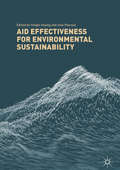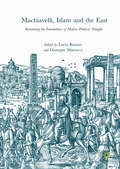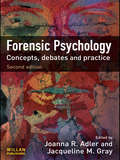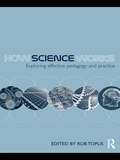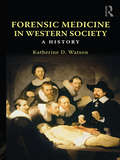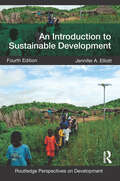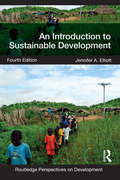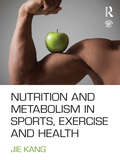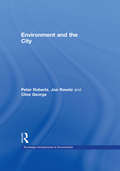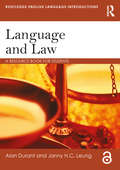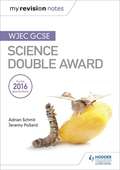- Table View
- List View
Aid Effectiveness for Environmental Sustainability
by Yongfu Huang Unai PascualThis collection examines the role that foreign aid can play in dealing with the severe global challenge of climate change, one of the most pressing international development issues of the 21st century. Addressing the key threats of rising temperatures, changes in precipitation, coastal erosion and natural disasters, the book considers the implications for policy and future research, particularly in developing countries. Focusing on the worth of foreign aid in ensuring environmental sustainability, this collection consider how it can be used to improve access to sustainable energy, to promote efficient use of energy resources, to improve emission reduction and support the preservation of biodiversity in forests. Advancing our knowledge about foreign aid and climate change, it provides policy recommendations for the donors and recipient country governments. A cutting edge text on one of the most pressing international development issues of this century, this is key reading for all scholars of international development and climate change.
Aid Effectiveness for Environmental Sustainability
by Yongfu Huang Unai PascualThis collection examines the role that foreign aid can play in dealing with the severe global challenge of climate change, one of the most pressing international development issues of the 21st century. Addressing the key threats of rising temperatures, changes in precipitation, coastal erosion and natural disasters, the book considers the implications for policy and future research, particularly in developing countries. Focusing on the worth of foreign aid in ensuring environmental sustainability, this collection consider how it can be used to improve access to sustainable energy, to promote efficient use of energy resources, to improve emission reduction and support the preservation of biodiversity in forests. Advancing our knowledge about foreign aid and climate change, it provides policy recommendations for the donors and recipient country governments. A cutting edge text on one of the most pressing international development issues of this century, this is key reading for all scholars of international development and climate change.
Machiavelli, Islam and the East: Reorienting the Foundations of Modern Political Thought
by Lucio Biasiori Giuseppe MarcocciThis volume provides the first survey of the unexplored connections between Machiavelli’s work and the Islamic world, running from the Arabic roots of The Prince to its first translations into Ottoman Turkish and Arabic. It investigates comparative descriptions of non-European peoples, Renaissance representations of Muḥammad and the Ottoman military discipline, a Jesuit treatise in Persian for a Mughal emperor, peculiar readers from Brazil to India, and the parallel lives of Machiavelli and the bureaucrat Celālzāde Muṣṭafá. Ten distinguished scholars analyse the backgrounds, circulation and reception of Machiavelli’s writings, focusing on many aspects of the mutual exchange of political theories and grammars between East and West. A significant contribution to attempts by current scholarship to challenge any rigid separation within Eurasia, this volume restores a sense of the global spreading of books, ideas and men in the past.
Machiavelli, Islam and the East: Reorienting the Foundations of Modern Political Thought
by Lucio Biasiori Giuseppe MarcocciThis volume provides the first survey of the unexplored connections between Machiavelli’s work and the Islamic world, running from the Arabic roots of The Prince to its first translations into Ottoman Turkish and Arabic. It investigates comparative descriptions of non-European peoples, Renaissance representations of Muḥammad and the Ottoman military discipline, a Jesuit treatise in Persian for a Mughal emperor, peculiar readers from Brazil to India, and the parallel lives of Machiavelli and the bureaucrat Celālzāde Muṣṭafá. Ten distinguished scholars analyse the backgrounds, circulation and reception of Machiavelli’s writings, focusing on many aspects of the mutual exchange of political theories and grammars between East and West. A significant contribution to attempts by current scholarship to challenge any rigid separation within Eurasia, this volume restores a sense of the global spreading of books, ideas and men in the past.
The Primary Science and Technology Encyclopedia
by Christopher Collier Dan Davies Alan Howe Kendra McMahonUnique in its field, The Primary Science Encyclopedia brings together in one indispensable reference volume over 250 entries covering a wide range of topics and ideas. The book provides clear descriptions, definitions and explanations of difficult scientific concepts, carefully chosen to reflect the needs of those involved in primary science education. In addition, this encyclopedia explains clearly how to teach scientific and technological ideas in a relevant and appropriate way. Extended entries are included on topics such as creativity, thinking skills and theories of learning and the book also provides insight into cross-curricular work, assessment and classroom organisation in the primary science classroom. Compiled by authors with a wealth of experience in primary science and technology teaching, this book contains: Over 250 entries; Scientific definitions and pedagogical explanations; Extensive commentaries of current issues in primary science; A who's who of current and historical figures in the field of science and science education; Annotated further reading lists. This encyclopedia will be of interest to all teachers of 5 to 11-year-olds and anyone concerned with primary science and design and technology education.
The Primary Science and Technology Encyclopedia
by Christopher Collier Dan Davies Alan Howe Kendra McMahonUnique in its field, The Primary Science Encyclopedia brings together in one indispensable reference volume over 250 entries covering a wide range of topics and ideas. The book provides clear descriptions, definitions and explanations of difficult scientific concepts, carefully chosen to reflect the needs of those involved in primary science education. In addition, this encyclopedia explains clearly how to teach scientific and technological ideas in a relevant and appropriate way. Extended entries are included on topics such as creativity, thinking skills and theories of learning and the book also provides insight into cross-curricular work, assessment and classroom organisation in the primary science classroom. Compiled by authors with a wealth of experience in primary science and technology teaching, this book contains: Over 250 entries; Scientific definitions and pedagogical explanations; Extensive commentaries of current issues in primary science; A who's who of current and historical figures in the field of science and science education; Annotated further reading lists. This encyclopedia will be of interest to all teachers of 5 to 11-year-olds and anyone concerned with primary science and design and technology education.
Forensic Psychology: Concepts, Debates and Practice
by Joanna R. Adler Jacqueline M GrayThis book brings together academics, practitioners and experts in the field of forensic psychology to demonstrate the scope of the discipline and push its parameters. Its aim is to go beyond introductory texts to challenge perceptions, to raise questions for research and to pose problems for practice. The editors hope to inspire and stimulate debate about how forensic psychology can aid the practice of justice. The book is divided into six sections, addressing key topics from the discipline: investigation and prosecution; testimony and evidence; serious and persistent offending; treatment as intervention; intervention and prevention and punishment and corrections. The contributors are drawn from the UK, the USA and Australia.This updated, revised and significantly expanded edition develops the picture of diversity and depth of forensic psychology; considers ways in which the discipline has progressed and identifies challenges for its future sustainability and growth. includes a new section on treatment as intervention with contributions on personality disordered offenders; anger control group work with forensic psychiatric inpatients; and developments in treatment for drug misuse offenders additional chapters throughout including contributions on UK police interviews; the investigation and prosecutoin of rape; the effect of gender in the courtroom; forensic psychology and terrorism; the aetiology of genocide; self harm in prisons; post-corrections reintegration and many more an innovative textbook on forensic psychology exploring application of the subject and setting forensic psychology in a broader context demonstrates ways in which forensic psychology can aid the practice of criminal justice This book will be essential reading for students of forensic psychology and practitioners working in the field.
Forensic Psychology: Concepts, Debates and Practice
by Joanna R. Adler Jacqueline M GrayThis book brings together academics, practitioners and experts in the field of forensic psychology to demonstrate the scope of the discipline and push its parameters. Its aim is to go beyond introductory texts to challenge perceptions, to raise questions for research and to pose problems for practice. The editors hope to inspire and stimulate debate about how forensic psychology can aid the practice of justice. The book is divided into six sections, addressing key topics from the discipline: investigation and prosecution; testimony and evidence; serious and persistent offending; treatment as intervention; intervention and prevention and punishment and corrections. The contributors are drawn from the UK, the USA and Australia.This updated, revised and significantly expanded edition develops the picture of diversity and depth of forensic psychology; considers ways in which the discipline has progressed and identifies challenges for its future sustainability and growth. includes a new section on treatment as intervention with contributions on personality disordered offenders; anger control group work with forensic psychiatric inpatients; and developments in treatment for drug misuse offenders additional chapters throughout including contributions on UK police interviews; the investigation and prosecutoin of rape; the effect of gender in the courtroom; forensic psychology and terrorism; the aetiology of genocide; self harm in prisons; post-corrections reintegration and many more an innovative textbook on forensic psychology exploring application of the subject and setting forensic psychology in a broader context demonstrates ways in which forensic psychology can aid the practice of criminal justice This book will be essential reading for students of forensic psychology and practitioners working in the field.
The Syllable in Speech Production: Perspectives on the Frame Content Theory
by Barbara L. Davis Krisztina ZajdoAs a testament to the scope of Peter MacNeilage’s scholarly work across his 40 year career, contributions to this tribute volume represent a broad spectrum of the seminal issues addressed by phonetic and evolutionary science over a number of years. Approaches to the problems raised by attempting to understand these fundamental topics are illustrated in the broad diversity of paradigms represented in the volume. This diversity in itself is a tribute to the breadth of scholarly questions pursued by MacNeilage across his career. Chapters are arranged around five thematic areas. Two themes, Evolutionary Perspectives on Speech Production and Acquisition of Speech, reflect the major thrust of Peter’s scholarly career over the past 25 years. The other themes are reflective of the broad implications of MacNeilage’s work for scholars in disparate scientific domains. One of the strengths of this volume is the unitary focus of contributions by scientists from diverse scientific backgrounds in considering the applicability of the Frame Content Theory within their own scholarly perspectives. Thematic strands in the volume include: - Evolutionary Perspectives on Speech Production - Neurobiological Aspects of Speech - Perception / Action Relationships - Acquisition of Speech Production Skill - Modeling and Movement - Alternative Perspectives on the Syllable.
The Syllable in Speech Production: Perspectives on the Frame Content Theory
by Barbara L. Davis Krisztina ZajdoAs a testament to the scope of Peter MacNeilage’s scholarly work across his 40 year career, contributions to this tribute volume represent a broad spectrum of the seminal issues addressed by phonetic and evolutionary science over a number of years. Approaches to the problems raised by attempting to understand these fundamental topics are illustrated in the broad diversity of paradigms represented in the volume. This diversity in itself is a tribute to the breadth of scholarly questions pursued by MacNeilage across his career. Chapters are arranged around five thematic areas. Two themes, Evolutionary Perspectives on Speech Production and Acquisition of Speech, reflect the major thrust of Peter’s scholarly career over the past 25 years. The other themes are reflective of the broad implications of MacNeilage’s work for scholars in disparate scientific domains. One of the strengths of this volume is the unitary focus of contributions by scientists from diverse scientific backgrounds in considering the applicability of the Frame Content Theory within their own scholarly perspectives. Thematic strands in the volume include: - Evolutionary Perspectives on Speech Production - Neurobiological Aspects of Speech - Perception / Action Relationships - Acquisition of Speech Production Skill - Modeling and Movement - Alternative Perspectives on the Syllable.
How Science Works: Exploring effective pedagogy and practice
by Rob ToplisHow Science Works provides student and practising teachers with a comprehensive introduction to one of the most dramatic changes to the secondary science curriculum.? Underpinned by the latest research in the field, it explores the emergence and meaning of How Science Works and reviews major developments in pedagogy and practice. With chapters structured around three key themes - why How Science Works, what it is and how to teach it – expert contributors explore issues including the need for curriculum change, arguments for scientific literacy for all, school students’ views about science, what we understand about scientific methods, types of scientific enquiry, and, importantly, effective pedagogies and their implications for practice. Aiming to promote discussion and reflection on the ways forward for this new and emerging area of the school science curriculum, it considers: teaching controversial issues in science argumentation and questioning for effective teaching enhancing investigative science and developing reasoned scientific judgments the role of ICT in exploring How Science Works teaching science outside the classroom. How Science Works is a source of guidance for all student, new and experienced teachers of secondary science, interested in investigating how the curriculum can provide creativity and engagement for all school students.
How Science Works: Exploring effective pedagogy and practice
by Rob ToplisHow Science Works provides student and practising teachers with a comprehensive introduction to one of the most dramatic changes to the secondary science curriculum.? Underpinned by the latest research in the field, it explores the emergence and meaning of How Science Works and reviews major developments in pedagogy and practice. With chapters structured around three key themes - why How Science Works, what it is and how to teach it – expert contributors explore issues including the need for curriculum change, arguments for scientific literacy for all, school students’ views about science, what we understand about scientific methods, types of scientific enquiry, and, importantly, effective pedagogies and their implications for practice. Aiming to promote discussion and reflection on the ways forward for this new and emerging area of the school science curriculum, it considers: teaching controversial issues in science argumentation and questioning for effective teaching enhancing investigative science and developing reasoned scientific judgments the role of ICT in exploring How Science Works teaching science outside the classroom. How Science Works is a source of guidance for all student, new and experienced teachers of secondary science, interested in investigating how the curriculum can provide creativity and engagement for all school students.
Forensic Medicine in Western Society: A History
by Katherine D. WatsonThe first book of its kind, Forensic Medicine in Western Society: A History draws on the most recent developments in the historiography, to provide an overview of the history of forensic medicine in the West from the medieval period to the present day. Taking an international, comparative perspective on the changing nature of the relationship between medicine, law and society, it examines the growth of medico-legal ideas, institutions and practices in Britain, Europe (principally France, Italy and Germany) and the United States. Following a thematic structure within a broad chronological framework, the book focuses on practitioners, the development of notions of ‘expertise’ and the rise of the expert, the main areas of the criminal law to which forensic medicine contributed, medical attitudes towards the victims and perpetrators of crime, and the wider influences such attitudes had. It thus develops an understanding of how medicine has played an active part in shaping legal, political and social change. Including case studies which provide a narrative context to tie forensic medicine to the societies in which it was practiced, and a further reading section at the end of each chapter, Katherine D. Watson creates a vivid portrait of a topic of relevance to social historians and students of the history of medicine, law and crime.
Forensic Medicine in Western Society: A History
by Katherine D. WatsonThe first book of its kind, Forensic Medicine in Western Society: A History draws on the most recent developments in the historiography, to provide an overview of the history of forensic medicine in the West from the medieval period to the present day. Taking an international, comparative perspective on the changing nature of the relationship between medicine, law and society, it examines the growth of medico-legal ideas, institutions and practices in Britain, Europe (principally France, Italy and Germany) and the United States. Following a thematic structure within a broad chronological framework, the book focuses on practitioners, the development of notions of ‘expertise’ and the rise of the expert, the main areas of the criminal law to which forensic medicine contributed, medical attitudes towards the victims and perpetrators of crime, and the wider influences such attitudes had. It thus develops an understanding of how medicine has played an active part in shaping legal, political and social change. Including case studies which provide a narrative context to tie forensic medicine to the societies in which it was practiced, and a further reading section at the end of each chapter, Katherine D. Watson creates a vivid portrait of a topic of relevance to social historians and students of the history of medicine, law and crime.
An Introduction to Sustainable Development
by Jennifer ElliottThis fourth edition has been comprehensively rewritten and updated to provide a concise, well illustrated and accessible introduction to the characteristics, challenges and opportunities of sustainable development with particular reference to developing countries. The contested nature of sustainable development is explored through a detailed consideration of changing ideas and practices within environmentalism and development thinking. The text identifies the different actors involved (from institutions of global governance through to community based organisations), the policies and mechanisms through which sustainable development is being sought and considers the outcomes for particular groups and environments in both rural and urban contexts. ?? This edition places stronger emphasis on the global challenges of sustainable development with an understanding of inter-linked crises in climate, energy, economy, poverty and social injustice. It explores how these issues are leading to deep questioning of what sustainable development is, what it should be, and how sustainable development policies and mechanisms are being reconsidered. The book gives new consideration to the challenge of achieving lower carbon growth, climate adaptation, and the implications on sustainable development of rapidly expanding economies, including China and India. It contains greater discussion of how civil society movements influence outcomes of international climate policy, as well as technological developments in energy and agriculture. The text also contains a substantially expanded discussion of how poverty remains central to sustainable development challenges, as revealed through the Millennium Ecosystem Assessment and Millennium Development Goals. This invaluable text retains the core message that sustainable development has become central to debates about environment and development. Containing a substantial number of new boxed case studies, learning outcomes, chapter summaries, discussion questions, further reading and websites, this text provides an essential introduction for students.
An Introduction to Sustainable Development
by Jennifer ElliottThis fourth edition has been comprehensively rewritten and updated to provide a concise, well illustrated and accessible introduction to the characteristics, challenges and opportunities of sustainable development with particular reference to developing countries. The contested nature of sustainable development is explored through a detailed consideration of changing ideas and practices within environmentalism and development thinking. The text identifies the different actors involved (from institutions of global governance through to community based organisations), the policies and mechanisms through which sustainable development is being sought and considers the outcomes for particular groups and environments in both rural and urban contexts. ?? This edition places stronger emphasis on the global challenges of sustainable development with an understanding of inter-linked crises in climate, energy, economy, poverty and social injustice. It explores how these issues are leading to deep questioning of what sustainable development is, what it should be, and how sustainable development policies and mechanisms are being reconsidered. The book gives new consideration to the challenge of achieving lower carbon growth, climate adaptation, and the implications on sustainable development of rapidly expanding economies, including China and India. It contains greater discussion of how civil society movements influence outcomes of international climate policy, as well as technological developments in energy and agriculture. The text also contains a substantially expanded discussion of how poverty remains central to sustainable development challenges, as revealed through the Millennium Ecosystem Assessment and Millennium Development Goals. This invaluable text retains the core message that sustainable development has become central to debates about environment and development. Containing a substantial number of new boxed case studies, learning outcomes, chapter summaries, discussion questions, further reading and websites, this text provides an essential introduction for students.
The Archaeology of Human Bones
by Simon MaysThe Archaeology of Human Bones provides an up to date account of the scientific analysis of human skeletal remains from archaeological sites. This completely revised edition reflects the latest developments in scientific techniques for studying human skeletons and the latest applications of those techniques in archaeology. In particular, the sections on ancient DNA and bone stable isotopes have been comprehensively updated, and two completely new chapters have been introduced, covering metric study of the postcranial skeleton and ethical dimensions of the study of human remains. The Archaeology of Human Bones introduces students to the anatomy of bones and teeth, utilising a large number of images. It analyzes the biasing effects of decay and incomplete recovery on burial data from archaeological sites, and discusses what we may learn about burial rites from human remains. Subsequent chapters focus on demographic analysis of earlier populations, normal skeletal variation, disease and injury, isotopic and DNA analysis of bone, the study of cremated bone and ethical aspects of working with ancient human remains. Current scientific methods are explained, alongside a critical discussion of their strengths and weaknesses. The ways in which scientific analyses of human skeletal remains can contribute to tackling major archaeological or historical issues is illustrated by means of examples drawn from studies from around the world. Technical jargon is kept to a minimum, and each chapter contains a summary of the main points that a student should grasp and a list of further reading targeted to enable students to follow up major issues covered in the book. Featuring case studies from around the world and with copious illustrations, The Archaeology of Human Bones continues to be a crucial work for students of archaeology.
The Archaeology of Human Bones
by Simon MaysThe Archaeology of Human Bones provides an up to date account of the scientific analysis of human skeletal remains from archaeological sites. This completely revised edition reflects the latest developments in scientific techniques for studying human skeletons and the latest applications of those techniques in archaeology. In particular, the sections on ancient DNA and bone stable isotopes have been comprehensively updated, and two completely new chapters have been introduced, covering metric study of the postcranial skeleton and ethical dimensions of the study of human remains. The Archaeology of Human Bones introduces students to the anatomy of bones and teeth, utilising a large number of images. It analyzes the biasing effects of decay and incomplete recovery on burial data from archaeological sites, and discusses what we may learn about burial rites from human remains. Subsequent chapters focus on demographic analysis of earlier populations, normal skeletal variation, disease and injury, isotopic and DNA analysis of bone, the study of cremated bone and ethical aspects of working with ancient human remains. Current scientific methods are explained, alongside a critical discussion of their strengths and weaknesses. The ways in which scientific analyses of human skeletal remains can contribute to tackling major archaeological or historical issues is illustrated by means of examples drawn from studies from around the world. Technical jargon is kept to a minimum, and each chapter contains a summary of the main points that a student should grasp and a list of further reading targeted to enable students to follow up major issues covered in the book. Featuring case studies from around the world and with copious illustrations, The Archaeology of Human Bones continues to be a crucial work for students of archaeology.
Nutrition and Metabolism in Sports, Exercise and Health
by Jie KangA key determinant of successful athletic performance is the high-level energy transformation which begins with combustion of the food that we eat. By developing a sound understanding of good nutrition we can improve athletic performance, help maintain good health and prevent disease. This clear and comprehensive introduction to nutrition in sport, exercise and health goes further than any other textbook in integrating key nutritional facts, concepts and dietary guidelines with a thorough discussion of the fundamental biological science underpinning our physiological and metabolic processes. By clearly explaining how nutrients function within our biological system, the book helps students to develop a better understanding of the underlying mechanisms, which, in turn, will help the student to apply their knowledge in practice. The book includes in depth discussion of key contemporary topics within nutrition including: nutrient bioenergetics nutrition and metabolic disease nutritional ergogenic aids nutrition for special populations nutritional assessment. Each chapter includes useful pedagogical features, including case studies, review questions, definitions of key terms, and practical laboratory exercises – such as techniques for assessing nutritional status, body composition and physical activity patterns. A companion website offers additional teaching and learning features, such as PowerPoint slides, multiple-choice question banks and web links. As the most up-to-date introduction to sport and exercise nutrition currently available, this book is essential reading for all students of sport and exercise science, kinesiology, physical therapy, nutrition, dietetics or health sciences. Visit the companion website at www.routledge.com/cw/kang
Nutrition and Metabolism in Sports, Exercise and Health
by Jie KangA key determinant of successful athletic performance is the high-level energy transformation which begins with combustion of the food that we eat. By developing a sound understanding of good nutrition we can improve athletic performance, help maintain good health and prevent disease. This clear and comprehensive introduction to nutrition in sport, exercise and health goes further than any other textbook in integrating key nutritional facts, concepts and dietary guidelines with a thorough discussion of the fundamental biological science underpinning our physiological and metabolic processes. By clearly explaining how nutrients function within our biological system, the book helps students to develop a better understanding of the underlying mechanisms, which, in turn, will help the student to apply their knowledge in practice. The book includes in depth discussion of key contemporary topics within nutrition including: nutrient bioenergetics nutrition and metabolic disease nutritional ergogenic aids nutrition for special populations nutritional assessment. Each chapter includes useful pedagogical features, including case studies, review questions, definitions of key terms, and practical laboratory exercises – such as techniques for assessing nutritional status, body composition and physical activity patterns. A companion website offers additional teaching and learning features, such as PowerPoint slides, multiple-choice question banks and web links. As the most up-to-date introduction to sport and exercise nutrition currently available, this book is essential reading for all students of sport and exercise science, kinesiology, physical therapy, nutrition, dietetics or health sciences. Visit the companion website at www.routledge.com/cw/kang
Environment and the City
by Joe Ravetz Clive George Joe Howe Peter W. RobertsFor the first time at the beginning of the twenty-first century, urban dwellers outnumber rural residents and this trend is set to continue. Consequently one of the most pressing issues of our time is how to square the social and economic development of cities with their environmental limits and those of the wider environment. The theme of the environment and city is topical at every level, from the politics of global trade to local community networks. Environment and the City looks at the evolution of cities in the developed and the developing world and the implications for resource consumption and environmental impacts. It takes a cross-cutting approach with new thinking on multiple geographies – the configuration of networks, exclusion, consumption, risk and ecological footprint. Urban environmental themes and their related social, economic and political agendas are outlined. In turn the environmental impacts and environmental agendas relating to key sectors of the urban economy are discussed. The global context to such issues is then explored before the practical tools and methods of urban environmental management are investigated. The theme of the sustainable city emerges from this – not so much as a standard menu, but as a learning process between all sections of society. This book, a valuable resource, provides a concise, accessible route map for all students interested in the environmental issues emanating from our urban society. Written to aid student understanding, the easily navigable text features boxed practical examples, discussion points, signposts to reading and websites, and a glossary.
Environment and the City
by Joe Ravetz Clive George Joe Howe Peter W. RobertsFor the first time at the beginning of the twenty-first century, urban dwellers outnumber rural residents and this trend is set to continue. Consequently one of the most pressing issues of our time is how to square the social and economic development of cities with their environmental limits and those of the wider environment. The theme of the environment and city is topical at every level, from the politics of global trade to local community networks. Environment and the City looks at the evolution of cities in the developed and the developing world and the implications for resource consumption and environmental impacts. It takes a cross-cutting approach with new thinking on multiple geographies – the configuration of networks, exclusion, consumption, risk and ecological footprint. Urban environmental themes and their related social, economic and political agendas are outlined. In turn the environmental impacts and environmental agendas relating to key sectors of the urban economy are discussed. The global context to such issues is then explored before the practical tools and methods of urban environmental management are investigated. The theme of the sustainable city emerges from this – not so much as a standard menu, but as a learning process between all sections of society. This book, a valuable resource, provides a concise, accessible route map for all students interested in the environmental issues emanating from our urban society. Written to aid student understanding, the easily navigable text features boxed practical examples, discussion points, signposts to reading and websites, and a glossary.
Language and Law: A resource book for students (Routledge English Language Introductions)
by Alan Durant Janny HC LeungLanguage plays an essential role both in creating law and in governing its implementation. Providing an accessible and comprehensive introduction to this subject, Language and Law: describes the different registers and genres that make up spoken and written legal language and how they develop over time; analyses real-life examples drawn from court cases from different parts of the world, illustrating the varieties of English used in the courtroom by speakers occupying different roles; addresses the challenges presented to our notions of law and regulation by online communication; discusses the complex role of translation in bilingual and multilingual jurisdictions, including Hong Kong and Canada; and provides readings from key scholars in the discipline, including Lawrence Solan, Peter Goodrich, Marianne Constable, David Mellinkoff, and Chris Heffer. With a wide range of activities throughout, this accessible textbook is essential reading for anyone studying language and law or forensic linguistics. Sections A, B, and C of this book are freely available as a downloadable Open Access PDF under a Creative Commons Attribution-Non Commercial-No Derivatives 4.0 license available at http://www.taylorfrancis.com/books/e/9781315436258
My Revision Notes: WJEC GCSE Science Double Award (PDF)
by Adrian Schmit Jeremy PollardExam Board: WJEC Level: GCSE Subject: Science First Teaching: September 2016 First Exam: Summer 2018 Target success in Science with this proven formula for effective, structured revision; key content coverage is combined with exam-style tasks and practical tips to create a revision guide that students can rely on to review, strengthen and test their knowledge. With My Revision Notes, every student can: - Plan and manage a successful revision programme using the topic-by-topic planner - Consolidate subject knowledge by working through clear and focused content coverage - Test understanding and identify areas for improvement with regular 'Now Test Yourself' tasks and answers - Improve exam technique through practice questions, expert tips and examples of typical mistakes to avoid - Get exam ready with extra quick quizzes and answers to the practice questions available online Please note that some of the quizzes from the WJEC GCSE My Revision Notes series are also used in the WJEC GCSE Teaching and Learning resources.
Environmental Economics (Routledge Textbooks in Environmental and Agricultural Economics)
by Shunsuke Managi Koichi KuriyamaThis book aids those concerned about environmental issues to firmly grasp relevant analytical methods and to comprehend the thought process behind environmental economics. It does so by drawing from specific environmental issues and at the same time providing commentary that facilitates understanding. This text contains in-depth explanations necessary for a thorough understanding of the fundamental aspects and importance of environmental economics. Environmental Economics seeks to elucidate the mechanisms that give rise to environmental problems by approaching environmental issues from an economic perspective. At the same time, it is a study aiming to indicate specific countermeasures that could resolve present environmental issues. This text has been put together in way that allows readers without specialized economics knowledge to easily understand the situation, issues and challenges of environmental economics.
